Estes Satellite Interceptor
Estes - Satellite Interceptor {Kit} (1296, 3027) [1978-1982]
Contributed by Dale Marshall and Tim Reidy
| Construction Rating: | starstarstarstarstar_border |
| Flight Rating: | starstarstarstarstar |
| Overall Rating: | starstarstarstarstar_border |
| Published: | 2010-06-22 |
| Diameter: | 0.98 inches |
| Length: | 22.25 inches |
| Manufacturer: | Estes  |
| Skill Level: | 2 |
| Style: | Futuristic/Exotic |
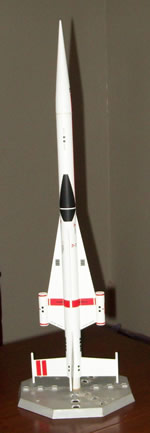
Brief:
This rocket is being reviewed by Dale Marshall and Tim Reidy. Tim has more building experience
so his comments are listed first.
Tim:
When I saw the list of kits that Estes was re-releasing as part of its
Classic Series, I was delighted to see the Satellite Interceptor on the list. It had been on my list of kits to clone,
and now Estes had saved me the work.
Dale:
Well I took a long hiatus from rocket building, so this one would be new for
me. I have the “younger brother” of this kit, the Crossbow SST, and it was a fun one to build and fly. I was
looking forward to getting this one done.
Construction:
Tim:
Upon opening and examining the kit, I saw it was
just like the original, with a couple of exceptions. Since there are no molded plastic parts, there is no tail cone in
the new kit, although a centering ring and piece of card stock would fix that. The balsa nose cone means a little more
work to finish the kit, but it is well worth it to ensure the new generation of modelers keeps up with the
fundamentals.
Dale:
Yea, I was a little surprised to find a balsa nosecone in this one. I have a
larger version of this nosecone in plastic and it looks really nice. I was pleased with the packaging of the kit, with
all of the smaller pieces in a separate plastic bag.
 Tim:
Tim:
So it was time to start
building. Assembly starts with fine sanding the laser-cut fins while still attached to the balsa sheet. A good
technique to save some finish sanding later. You then remove the fins from the scrap balsa, square the root edges and
round the leading edges. No problem there. The engine mount is next. It is straight forward, except that I don't care
for the new Estes engine hook, so I omit that and opt to friction fit later.
Dale:
I actually didn’t start with the fins, opting to build the engine mount
first to let it dry while I did some other work. I did include the engine hook because I don’t have a lot of luck
friction-fitting engines. I was very disappointed in the quality of the balsa fins in my kit. It was rough and took a
LOT of sanding to resemble anything near smooth. This is the first time I’ve run into this poor quality of balsa
in any kit from any manufacturer.
Tim:
Next step is to cut the tube marking guide from the instructions and mark the
tube. I still use the door frame method as illustrated. I marked the tube, extended the lines and dutifully labeled
them.
Dale:
Be sure to do all that after you fill the spirals with filler and sand it
down. Not that I’m talking from experience or anything.
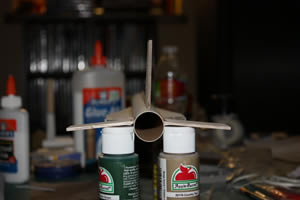
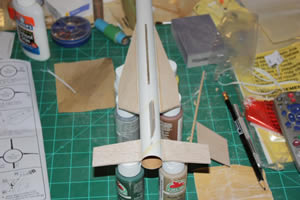
Tim:
Time to attach the fins. Here I ran into my first issue with the new version.
You first attach the wings, which end up being perpendicular to the vertical and sub fins. After the wings come the
stabilizers. Per the marking guide and the illustration in the instruction, the stabilizers are attached on the line
above the wings and angled down. Nowhere does it mention that it would be a good idea to sand the root edges of the
stabilizers at an angle to get a good glue joint with the body tube. I've looked at the instruction for the original
Satellite Interceptor, and the setup was a little better. The stabilizers were perpendicular to the vertical fins, and
the wings were angled down, although below the stabilizers, so they still came straight out of the body tube. A much
easier and stronger joint. I added the vertical and sub fins, and finished with the wing tubes and dowels to make it
look cool.
Dale:
I noticed the same thing with the rear fins – but not until I had tried
gluing them on stock first. Oops. Had to wipe off the glue, bevel the fins, and then attach them again. One thing I did
differently (by mistake, actually) was to mount the lower fin pointing backwards towards the tail in the same direction
as the upper tail fin. I like the way it looks. To support the fins I used some of my small paint bottles which turned
out to be the perfect size to make the angle correct. I used those bottles to support the rocket as I glued on each of
the fins and the wing tubes.
Tim:
After installing the last few steps involve adding the engine mount, launch
lug and shock cord, as well as the nose cone. I still prefer sewing elastic to the bare rubber shock cord Estes
returned to a
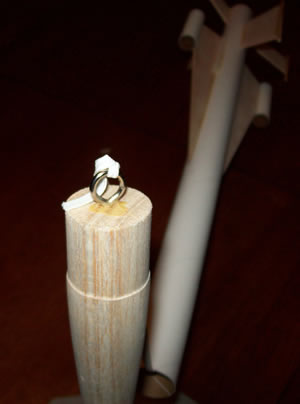 few years ago, so I substituted a longer piece of that. Engine mount and launch lug
went on as directed. Then I came to the nose cone. I've built a fair number of Estes kits and cloned many more with
balsa cones. We all know there are times you get balsa that seems as hard as oak and other times it is like warm
butter. You are directed to screw in the screw eye and go on your merry way. Old time kits always had you take it back
out and squirt glue in to give the eye a better setting. My son just built the Mini Max, and the eye isn't glued on
that one either. Personally I think it's an oversight that Estes should correct, but maybe it is by design. I still
opted for the glue.
few years ago, so I substituted a longer piece of that. Engine mount and launch lug
went on as directed. Then I came to the nose cone. I've built a fair number of Estes kits and cloned many more with
balsa cones. We all know there are times you get balsa that seems as hard as oak and other times it is like warm
butter. You are directed to screw in the screw eye and go on your merry way. Old time kits always had you take it back
out and squirt glue in to give the eye a better setting. My son just built the Mini Max, and the eye isn't glued on
that one either. Personally I think it's an oversight that Estes should correct, but maybe it is by design. I still
opted for the glue.
Dale:
I, too, did the "glue the screw eye in the nosecone bit". I find
myself doing that on every kit now. My nosecone had a pretty good consistency, but I found it difficult to get the
screw eye to go in straight. I used the stock rubber band and tri-fold mount and parachute.
Finishing:
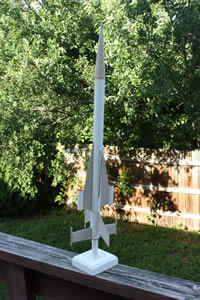 Tim:
Tim:
On to finishing. I prefer the
smooth look and strength of epoxy fillets, so I reinforced my fins with some 5 minute epoxy, and finished the fine
sanding of the nose cone and fins. I used thinned out Elmer's wood filler to finish all the balsa, and applied 2 coats
of Krylon white primer, sanding after each coat. I finished with 2 light coats of Krylon semi-gloss white. The decals
are sharp, so I was careful and took my time applying them. They are pretty thin, so I can see where they might tear
easily if not careful. Two light coats of Krylon clear acrylic, and I was done.
Dale:
I haven’t done the epoxy fillets before but I have read about them so I
may try that on my next build. I used two coats of gray primer (three on the fins) to get a pretty smooth finish. I
still have to work on my fin-filling techniques. I don’t like the Krylon white, but that’s all I had to work
with so that’s what I used. This time I did it without any runs in the paint. I saved the many decals until after
launching. This kit comes with a LOT of really nice decals!
Tim:
Build 4 out of 5 due to the angled stabilizers and not anchoring the eye in
the nose cone.
Dale:
Agreed. I think my rough fin balsa was an anomaly so I won’t ding Estes
for that even though it should have been caught in quality control.

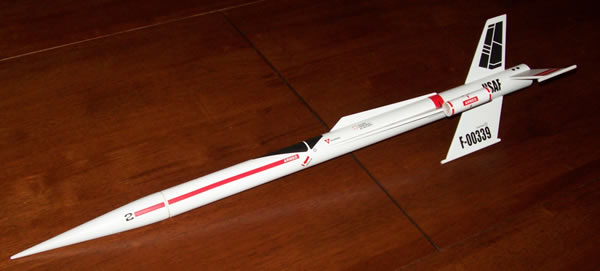
Construction Rating: 4 out of 5
Flight:
Tim:
I had a beautiful calm evening on a nice grassy soccer
field for the maiden launch. I prepped with a B6-4 and let 'er rip. I'm horrible at judging altitude, so let's just say
it went straight up, plenty high. I'm glad Estes replaced the plain white parachute with plain red ones now. They are
much easier to see against a cloudy sky. It came down softly with no damage. Since the rocket is light, and there was
no wind, I decided to try it on an A8-3 even though not on the recommended list. It was a recommended motor on the
original, so I thought it should do just fine. I was right. Again it flew straight and true, and returned safely.
Flight 5 out of 5.
Dale:
Unfortunately I didn’t have a calm day to fly my SI. Winds were
reasonably consistent, mostly about 5-10 MPH with occasional gusts (blew over my launch pad twice with a heavier rocket
on the
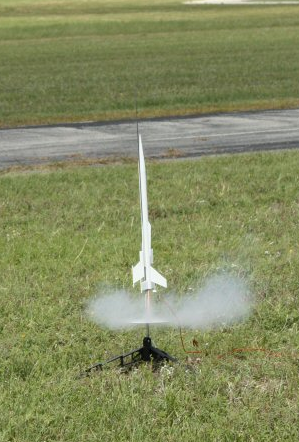 pad). Because of the winds, and the local RC plane club flying on the field at the
same time, I opted for the A8-3 for the first flight. I don’t have a large selection of engines right now because
of many recent launches. The first flight was straight up for about 150 feet, I think, not even arcing into the wind
all that much. Beautiful flight and the ‘chute popped just after apogee. It came down pretty fast, though,
probably because of the wind, and popped one of the rear fins when it hit the hard ground. A little Gorilla Glue and
the SI was ready to fly again. This time I used a B6-4 like Tim did, and the flight was amazing! Much higher and still
straight, and still a reasonably fast descent and that darn fin popped loose again. I found out why though – my
parachute was slightly melted. I must not have put enough wadding in. Oh well. Since I don’t have a spare
‘chute, I unfolded it as best as I could (there are now several spill holes in the ‘chute), stuffed some more
wadding in, and set it up on another B6-4. The wind was just too strong to try a C engine. The last flight was just
like the second one, except this time the 4-second delay was too much and the ‘chute got tangled in the fins and
the whole thing came down horizontally… which was a good thing because the rocket body created enough drag to
bring it down softly even though the ‘chute was full of holes.
pad). Because of the winds, and the local RC plane club flying on the field at the
same time, I opted for the A8-3 for the first flight. I don’t have a large selection of engines right now because
of many recent launches. The first flight was straight up for about 150 feet, I think, not even arcing into the wind
all that much. Beautiful flight and the ‘chute popped just after apogee. It came down pretty fast, though,
probably because of the wind, and popped one of the rear fins when it hit the hard ground. A little Gorilla Glue and
the SI was ready to fly again. This time I used a B6-4 like Tim did, and the flight was amazing! Much higher and still
straight, and still a reasonably fast descent and that darn fin popped loose again. I found out why though – my
parachute was slightly melted. I must not have put enough wadding in. Oh well. Since I don’t have a spare
‘chute, I unfolded it as best as I could (there are now several spill holes in the ‘chute), stuffed some more
wadding in, and set it up on another B6-4. The wind was just too strong to try a C engine. The last flight was just
like the second one, except this time the 4-second delay was too much and the ‘chute got tangled in the fins and
the whole thing came down horizontally… which was a good thing because the rocket body created enough drag to
bring it down softly even though the ‘chute was full of holes.
Flight 4.5 out of 5 due to a possibly undersized parachute.
Flight Rating: 5 out of 5
Summary:
Tim:
Overall impressions: I already have the Satellite
Interceptor's big and little brothers, namely the S.W.A.T. and Crossbow SST, so the SI is a fine addition to my
collection. Thanks Estes, and keep bringing back the Classics.
Dale:
Overall impressions: I agree with Tim that this is a great addition to the
fleet. I’m sure I’ll fly it many times in the future once I replace the parachute with something a little bit
larger. I’d really like to try it on a C6!
Overall Rating: 4 out of 5
Other Reviews
- Estes Satellite Interceptor By Jewel B. Butler Jr. (May 2, 2010)
Brief: This is one of the new Estes kits from their Classic series,Crossbow SST is another kit similar in design. They call it Cool and Futuristic. I agree with both descriptions. This is a sleek multi-fined with tubes which made me go wow and some great decals to really make it kind a nasty like it will seek out and destroy. It use a 18 mm engine with parachute recovery. ...
- Estes Satellite Interceptor By David O'Nan
Brief Older skill level 3 Estes kit introduced in 1978 and discontinued in 1982. Had one back in 1979 that I lost to a tree on its first flight. When I became a BAR this is one of the first kits I wanted to clone, but it was difficult because of the unique nose cone/tail cone combination. However, in 1997 Estes introduced the Wildfire kit (#2154, see picture), which re-introduced this plastic ...
 |
 |
Flights
 |
 |
Sponsored Ads
 |
 |












K.F. (July 8, 2010)